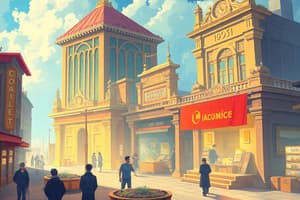Podcast
Questions and Answers
How does a higher price influence the quantity supplied according to the law of supply?
How does a higher price influence the quantity supplied according to the law of supply?
- It decreases the quantity supplied.
- It increases the quantity supplied. (correct)
- It eliminates the quantity supplied.
- It does not affect the quantity supplied.
What effect do higher input prices have on the supply of a product?
What effect do higher input prices have on the supply of a product?
- They decrease supply. (correct)
- They increase supply.
- They maintain supply.
- They have no effect on supply.
Which of the following factors is not a reason that can shift the supply curve?
Which of the following factors is not a reason that can shift the supply curve?
- Expectations of future prices
- Price of a good (correct)
- Technology advancements
- Input prices
In market supply, how is the overall supply determined?
In market supply, how is the overall supply determined?
What is the relationship between expectations of future price increases and current supply?
What is the relationship between expectations of future price increases and current supply?
Which of these statements describes a supply schedule?
Which of these statements describes a supply schedule?
How is the market supply curve derived?
How is the market supply curve derived?
What happens to production at very low prices according to supply theory?
What happens to production at very low prices according to supply theory?
What best describes a monopoly market structure?
What best describes a monopoly market structure?
How does an increase in the price of a normal good typically affect its quantity demanded?
How does an increase in the price of a normal good typically affect its quantity demanded?
What effect does a decrease in input prices have on the supply curve?
What effect does a decrease in input prices have on the supply curve?
What happens to the equilibrium price when there is a surplus in the market?
What happens to the equilibrium price when there is a surplus in the market?
Which of the following defines an inferior good?
Which of the following defines an inferior good?
Which of the following statements about movements along the supply curve is true?
Which of the following statements about movements along the supply curve is true?
If both supply and demand curves shift to the right, what can be expected?
If both supply and demand curves shift to the right, what can be expected?
In a situation where quantity demanded is greater than quantity supplied, this is referred to as what?
In a situation where quantity demanded is greater than quantity supplied, this is referred to as what?
In the context of substitute goods, what occurs when the price of one good rises?
In the context of substitute goods, what occurs when the price of one good rises?
What happens to the quantity demanded if the price of a complementary good rises?
What happens to the quantity demanded if the price of a complementary good rises?
What does the intersection point of the supply and demand curves represent?
What does the intersection point of the supply and demand curves represent?
What characterizes a perfectly competitive market?
What characterizes a perfectly competitive market?
What is the likely effect of a decrease in income on the quantity demanded of inferior goods?
What is the likely effect of a decrease in income on the quantity demanded of inferior goods?
Which factor is NOT a determinant of demand for a product?
Which factor is NOT a determinant of demand for a product?
Which factor does NOT cause a shift in the supply curve?
Which factor does NOT cause a shift in the supply curve?
What is the result of an increase in price for a good in terms of supply?
What is the result of an increase in price for a good in terms of supply?
Flashcards are hidden until you start studying
Study Notes
Market
- A market is a group of buyers and sellers interacting with the potential to trade
- Market types
- Perfectly competitive markets: buyers and sellers take market price as given
- Imperfectly competitive markets: individual buyers or sellers influence the price
Competitors in Market
- Perfectly Competitive Market:
- Multiple buyers & sellers, each having a small market share
- Homogeneous products
- Free entry and exit from the market
- Perfect information
- Imperfectly Competitive Market:
- Limited number of sellers and/or buyers
- Differentiated products
- Barriers to entry and exit
- Imperfect information
- Examples: Monopoly, Oligopoly, Monopolistic competition
Types of Markets
- Monopoly: One seller controls the entire supply and sets the price
- Oligopoly: Few sellers, who may avoid aggressive competition to maintain high prices
- Monopolistic Competition: Many sellers offer similar but differentiated products
Demand
- Represents a consumer's desire to purchase goods and services and their willingness to pay a specific price.
Quantity Demanded
- The amount of a good buyers are willing and able to purchase
Factors that Determine Individual Demand
- Price: Higher price, lower quantity demanded; Lower price, higher quantity demanded.
- Income: Lower income, lower demand; Higher income, higher demand.
- Normal Good: Demand increases with an increase in income
- Inferior Good: Demand decreases with an increase in income
- Price of Related Goods:
- Substitute Goods: Increase in price of one leads to an increase in demand for the other
- Complement Goods: Increase in price of one leads to a decrease in demand for the other
- Taste: Individual preferences and trends influence demand
Law of Demand
- Quantity demanded falls when price rises, and vice-versa (other things equal).
Shifts in the Demand Curve
- Factors Shifting Demand Curve to the Right (Increase in Demand):
- Increase in consumer income (for normal goods)
- Decrease in the price of a substitute good
- Decrease in the price of a complementary good
- Favorable change in consumer taste
- Expectations of future price increases
- Factors Shifting Demand Curve to the Left (Decrease in Demand):
- Decrease in consumer income (for normal goods)
- Increase in the price of a substitute good
- Increase in the price of a complementary good
- Unfavorable change in consumer taste
- Expectations of future price decreases
Demand Schedule and Demand Curve
- Demand Schedule: Table showing relationship between price and quantity demanded
- Demand Curve: Graph showing relationship between price and quantity demanded
Market Demand vs. Individual Demand
- Market Demand: Sum of individual demands for a good at various prices.
- Individual Demand: Specific demand of one consumer for a good at different prices.
Supply
- Represents the amount of a good that sellers are willing and able to sell.
Quantity Supplied
- The amount of a good sellers are willing and able to sell at a specific price.
Factors that Determine Individual Supply
- Price: Higher price, higher quantity supplied; Lower price, lower quantity supplied
- Input Prices: Higher input prices, lower supply; Lower input prices, higher supply
- Technology: Advancements in technology lower production costs and increase supply
- Expectations: Expectations of future price increases lead to reduced current supply
Law of Supply
- Quantity supplied rises when price rises, and vice-versa (other things equal).
The Supply Schedule and Supply Curve
- Supply Schedule: Table showing the relationship between price and quantity supplied.
- Supply Curve: Graph showing the relationship between price and quantity supplied.
Market Supply vs. Individual Supply
- Market Supply: Sum of individual supplies of all sellers in a market.
- Individual Supply: Specific supply of one seller for a good at various prices.
Shifts in the Supply Curve
- Factors Shifting the Supply Curve to the Right (Increase in Supply):
- Decrease in input prices
- Technological advancement
- Favorable weather conditions (for agricultural products)
- Expectations of future price decreases
- Factors Shifting the Supply Curve to the Left (Decrease in Supply):
- Increase in input prices
- Technological setbacks
- Unfavorable weather conditions (for agricultural products)
- Expectations of future price increases
Putting Supply and Demand Together
- Market equilibrium is where supply and demand curves intersect
- Equilibrium price: Price that balances supply and demand
- Equilibrium quantity: Quantity supplied and demanded at the equilibrium price
Equilibrium on a Graph
- Surplus: Quantity supplied exceeds quantity demanded
- Shortage: Quantity demanded exceeds quantity supplied
Law of Supply and Demand
- Price adjusts to bring quantity supplied and demanded into balance
Analyzing Changes in Equilibrium
- Identify whether the event shifts supply, demand, or both curves.
- Determine which direction the curve shifts (left or right).
- Use the supply-demand diagram to analyze the resulting changes in equilibrium price and quantity.
Expectations
- Expectations about future prices can influence current demand and supply decisions.
Demand Schedule and Demand Curve
- Demand schedule and demand curve visualize the relationship between price and quantity demanded.
Studying That Suits You
Use AI to generate personalized quizzes and flashcards to suit your learning preferences.





